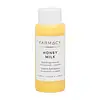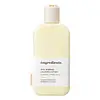What's inside
What's inside
 Key Ingredients
Key Ingredients

 Benefits
Benefits

 Ingredients Side-by-side
Ingredients Side-by-side

Aloe Barbadensis Leaf Juice
Skin ConditioningSaccharomyces Ferment Filtrate
HumectantPropanediol
SolventBetaine
HumectantIsopentyldiol
HumectantWater
Skin ConditioningGlycerin
Humectant1,2-Hexanediol
Skin ConditioningHoney Extract
HumectantCeramide NP
Skin ConditioningAnthemis Nobilis Flower Extract
MaskingPanthenol
Skin ConditioningSqualane
EmollientOpuntia Ficus-Indica Stem Extract
Skin ConditioningArginine
MaskingPolyacrylate Crosspolymer-6
Emulsion StabilisingPolyglyceryl-10 Stearate
Skin ConditioningGlucomannan
Skin ConditioningSodium Benzoate
MaskingPotassium Sorbate
PreservativeCitric Acid
BufferingSodium Phytate
Hydroxyacetophenone
AntioxidantHydrogenated Lecithin
EmulsifyingSucrose Stearate
EmollientCaprylyl Glycol
EmollientMaltodextrin
AbsorbentAloe Barbadensis Leaf Juice, Saccharomyces Ferment Filtrate, Propanediol, Betaine, Isopentyldiol, Water, Glycerin, 1,2-Hexanediol, Honey Extract, Ceramide NP, Anthemis Nobilis Flower Extract, Panthenol, Squalane, Opuntia Ficus-Indica Stem Extract, Arginine, Polyacrylate Crosspolymer-6, Polyglyceryl-10 Stearate, Glucomannan, Sodium Benzoate, Potassium Sorbate, Citric Acid, Sodium Phytate, Hydroxyacetophenone, Hydrogenated Lecithin, Sucrose Stearate, Caprylyl Glycol, Maltodextrin
Water
Skin ConditioningGlycerin
HumectantPropanediol
SolventCaprylic/Capric Triglyceride
MaskingCetyl Ethylhexanoate
Emollient1,2-Hexanediol
Skin ConditioningGlyceryl Stearate
EmollientPhenyl Trimethicone
Skin ConditioningC14-22 Alcohols
Emulsion StabilisingPolysorbate 60
EmulsifyingArginine
MaskingCoptis Japonica Root Extract
Skin ConditioningCarbomer
Emulsion StabilisingButylene Glycol
HumectantCorchorus Olitorius Leaf Extract
Skin ConditioningDaucus Carota Sativa Root Extract
Skin ConditioningIlex Paraguariensis Leaf Extract
PerfumingBorago Officinalis Extract
EmollientC12-20 Alkyl Glucoside
EmulsifyingCentella Asiatica Extract
CleansingGlucose
HumectantPolyglyceryl-10 Laurate
Skin ConditioningEthylhexylglycerin
Skin ConditioningTripeptide-1
Skin ConditioningCopper Tripeptide-1
Skin ConditioningPalmitoyl Pentapeptide-4
Skin ConditioningPalmitoyl Tripeptide-1
Skin ConditioningHexapeptide-9
Skin ConditioningHexapeptide-11
Skin ConditioningAcetyl Tetrapeptide-2
Skin ConditioningAcetyl Tetrapeptide-5
HumectantPalmitoyl Tripeptide-5
Skin ConditioningWater, Glycerin, Propanediol, Caprylic/Capric Triglyceride, Cetyl Ethylhexanoate, 1,2-Hexanediol, Glyceryl Stearate, Phenyl Trimethicone, C14-22 Alcohols, Polysorbate 60, Arginine, Coptis Japonica Root Extract, Carbomer, Butylene Glycol, Corchorus Olitorius Leaf Extract, Daucus Carota Sativa Root Extract, Ilex Paraguariensis Leaf Extract, Borago Officinalis Extract, C12-20 Alkyl Glucoside, Centella Asiatica Extract, Glucose, Polyglyceryl-10 Laurate, Ethylhexylglycerin, Tripeptide-1, Copper Tripeptide-1, Palmitoyl Pentapeptide-4, Palmitoyl Tripeptide-1, Hexapeptide-9, Hexapeptide-11, Acetyl Tetrapeptide-2, Acetyl Tetrapeptide-5, Palmitoyl Tripeptide-5
 Reviews
Reviews

Ingredients Explained
These ingredients are found in both products.
Ingredients higher up in an ingredient list are typically present in a larger amount.
1,2-Hexanediol is a synthetic liquid and another multi-functional powerhouse.
It is a:
- Humectant, drawing moisture into the skin
- Emollient, helping to soften skin
- Solvent, dispersing and stabilizing formulas
- Preservative booster, enhancing the antimicrobial activity of other preservatives
Arginine is an amino acid that is important for human development. Your body uses is it to produce hair keratin and skin collagen.
As a cosmetic ingredient, Arginine has antioxidant properties and can also help repair damaged skin. This ingredient is derived either synthetically or from animals.
Arginine isn't fungal acne safe when used in the presence of other lipids (fats, fatty acids, oils, esters, etc). Oils and fats occur naturally within the skin, so take caution when using Arginine if you're prone to fungal acne.
Learn more about ArginineGlycerin is already naturally found in your skin. It helps moisturize and protect your skin.
A study from 2016 found glycerin to be more effective as a humectant than AHAs and hyaluronic acid.
As a humectant, it helps the skin stay hydrated by pulling moisture to your skin. The low molecular weight of glycerin allows it to pull moisture into the deeper layers of your skin.
Hydrated skin improves your skin barrier; Your skin barrier helps protect against irritants and bacteria.
Glycerin has also been found to have antimicrobial and antiviral properties. Due to these properties, glycerin is often used in wound and burn treatments.
In cosmetics, glycerin is usually derived from plants such as soybean or palm. However, it can also be sourced from animals, such as tallow or animal fat.
This ingredient is organic, colorless, odorless, and non-toxic.
Glycerin is the name for this ingredient in American English. British English uses Glycerol/Glycerine.
Learn more about GlycerinPropanediol is an all-star ingredient. It softens, hydrates, and smooths the skin.
It’s often used to:
Propanediol is not likely to cause sensitivity and considered safe to use. It is derived from corn or petroleum with a clear color and no scent.
Learn more about PropanediolWater. It's the most common cosmetic ingredient of all. You'll usually see it at the top of ingredient lists, meaning that it makes up the largest part of the product.
So why is it so popular? Water most often acts as a solvent - this means that it helps dissolve other ingredients into the formulation.
You'll also recognize water as that liquid we all need to stay alive. If you see this, drink a glass of water. Stay hydrated!
Learn more about Water